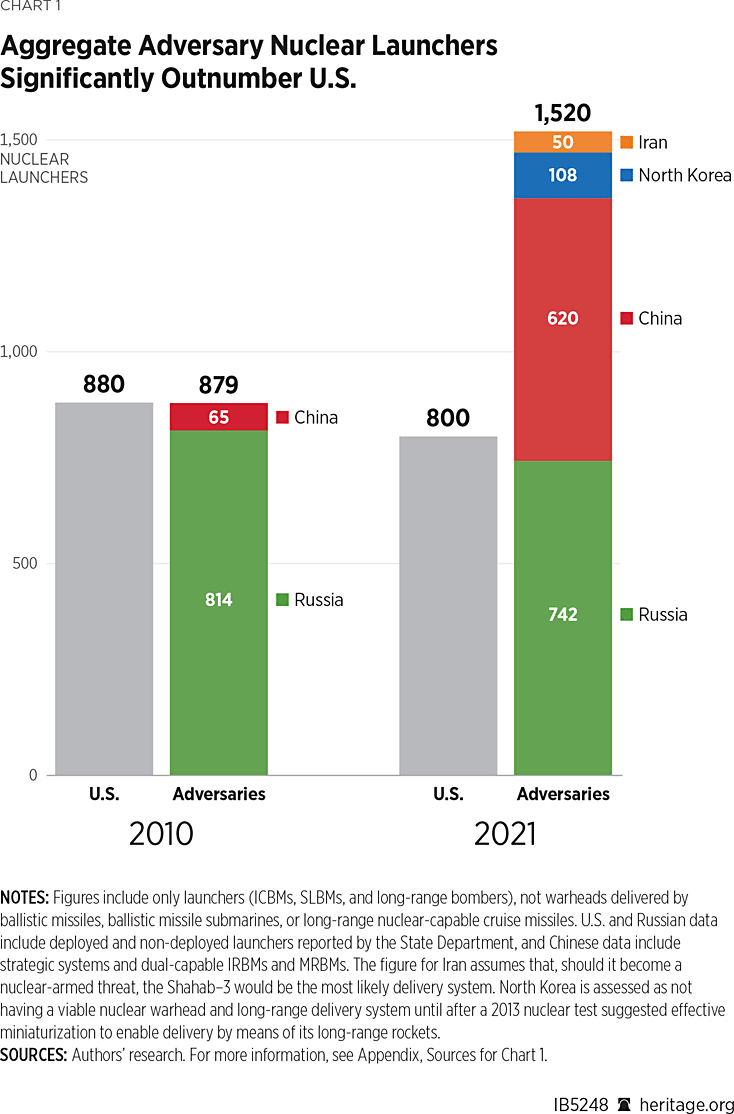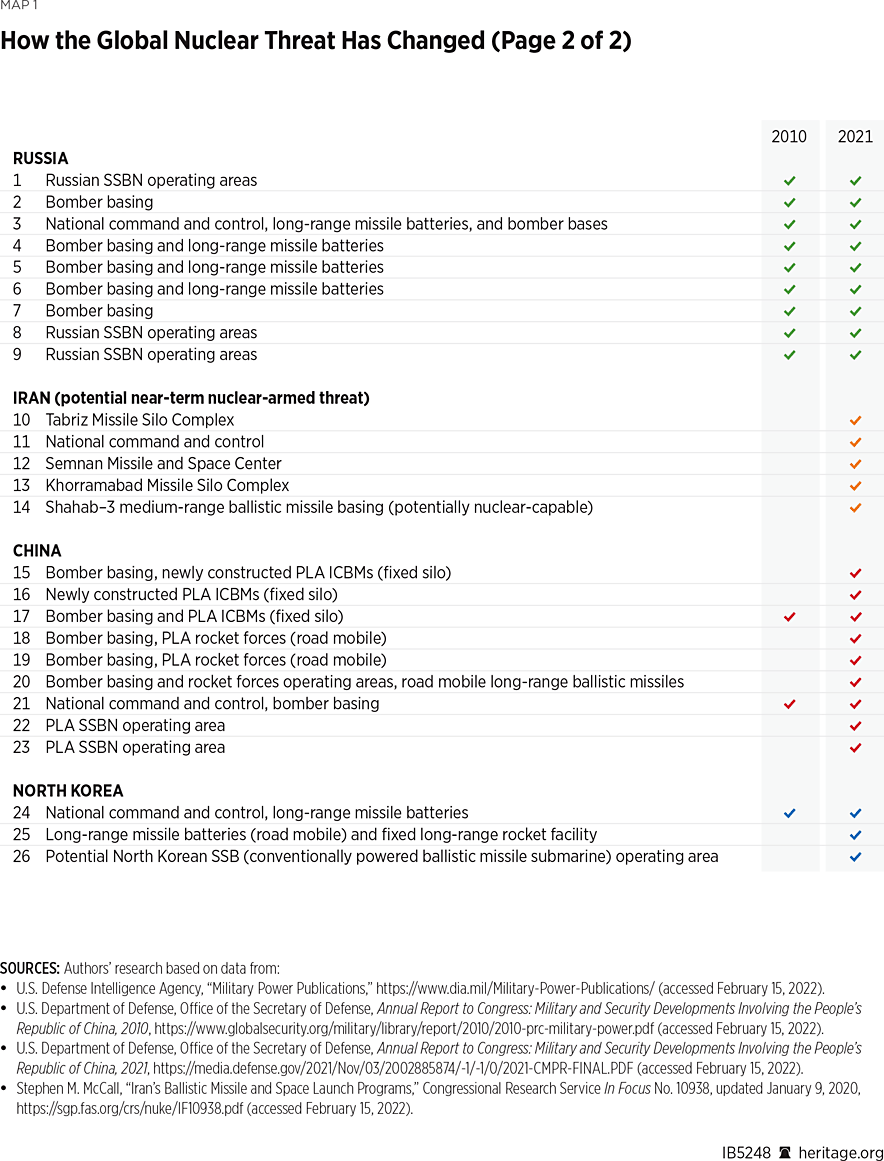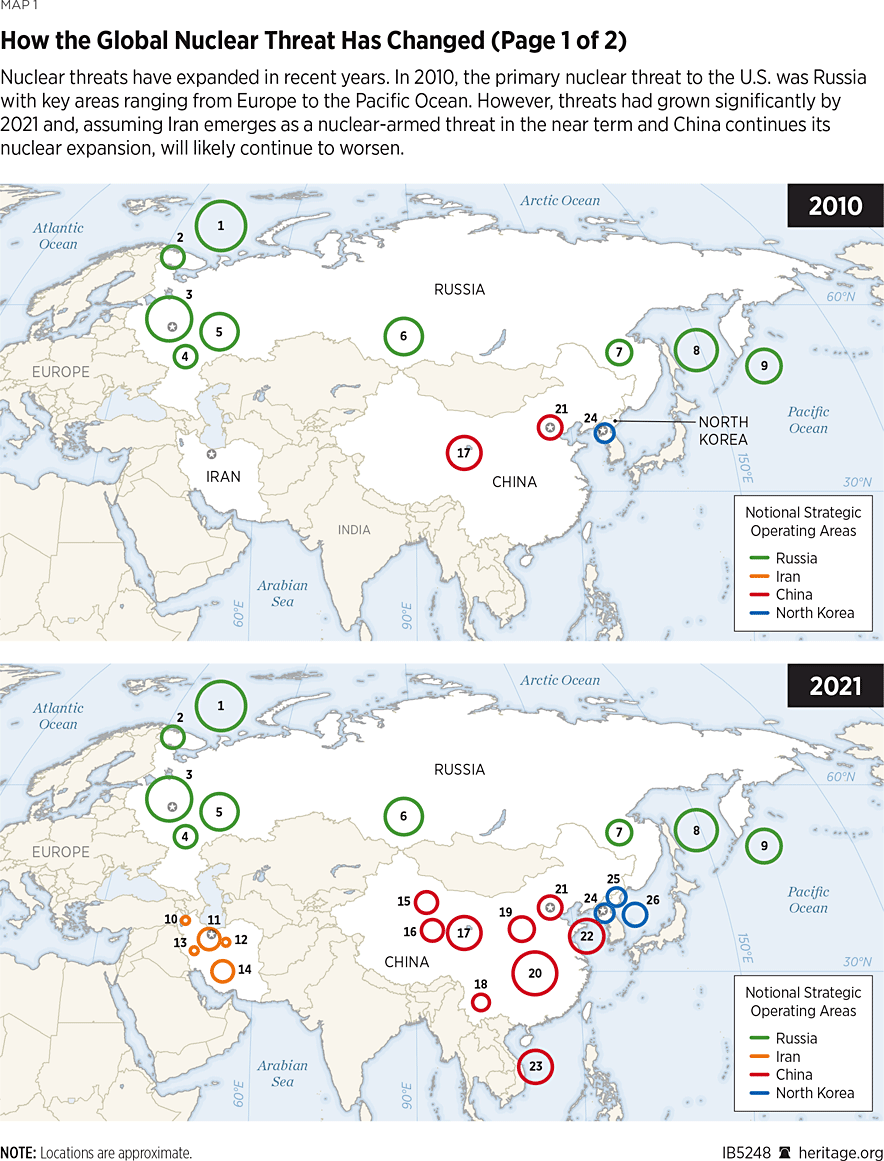On December 9, 2010, it was decided that the design of the Columbia-class ballistic missile submarine (SSBN) would include eight fewer missile tubes than the 24 found on the Ohio-class SSBN. Further, the Navy would build only 12 Columbia-class submarines as opposed to the 14 Ohio-class subs in the current fleet.REF The choice—roundly questioned at the time—was based on the prevailing optimism regarding the future strategic environment.
Today’s notably worsened threat environment warrants a critical review both of that optimistic assumption and of the requirements for America’s primary second-strike nuclear capability: the SSBN. To ensure that future U.S. sea-based nuclear capabilities have sufficient capacity to address growing threats, the Administration should consider design modification and procurement numbers for the SSBN fleet while accelerating development of the sea-launched cruise missile-nuclear (SLCM-N).
Background
On the day the decision finalizing the Columbia’s design was made, Russia had just signed the New Strategic Arms Reduction Treaty (New START) codifying limits on deployed strategic nuclear weapons. The Obama Administration’s Nuclear Posture Review (NPR) proclaimed that “Russia and the United States are no longer adversaries.”REF China maintained a minimum nuclear posture of less than 100 land-based intercontinental ballistic missiles (ICBMs).
The extraordinary technical and geopolitical developments being realized today—China’s nuclear breakout and Russia’s nuclear expansion rather than reduction—were generally not anticipated as the Obama Administration went about finalizing the nuclear force structure for the coming decades.REF According to a 2021 RAND Corporation study led by former Obama Administration official Frank Klotz, the decision to reduce the number of missiles in the Columbia-class design “was based in part on the assumption that the multi-decade reduction in U.S. nuclear delivery systems is unlikely to be suddenly and dramatically reversed.”REF
Amid the euphoria of President Barack Obama’s denuclearization efforts, senior leaders generally assured Congress that 16 tubes on 12 Columbia-class SSBNs would suffice for future and presumably less demanding scenarios. Yet curiously, Air Force General C. Robert Kehler, then Commander of U.S. Strategic Command, testified at the time that “USSTRATCOM does not support a reduction in Ohio-class missile tubes from 20 to 16 in today’s environment,”REF which was less threatening than the environment of 2022.REF “If the strategic environment deteriorated today,” he explained, “our only option to increase the number of deployed SLBM [submarine-launched ballistic missile] weapons is to upload weapons, which is limited by the number of tubes [per] SSBN.”REF He also argued that “[t]he capability differences between a 16 and 20 tube configuration would only be relevant in a significantly deteriorated strategic environment.”REF
Despite this possibility, Navy leadership insisted that, in addition to enabling cost savings, the combination of fewer missile tubes on fewer SSBNs was underpinned by the assumption that the strategic environment would continue to improve.REF
But “a significantly deteriorated strategic environment” is exactly what followed. Within years, what seemed like safe assumptions in 2010 regarding the state of geopolitics were overturned.
- North Korea and Pakistan got on trajectories to expand their nuclear arsenals and the means to deliver them.
- Russia violated the Intermediate-range Nuclear Forces Treaty and invaded Ukraine in 2014.
- At a time when the United States deploys only about 200 non-strategic gravity bombs, Moscow continues to increase its stockpile of at least 2,000 non-strategic nuclear weapons, which are unconstrained by New START, and is improving its capacity to upload warheads beyond New START’s limit of 1,550.REF
- Today, Russia appears to be poised to invade Ukraine for a second time.
The changes in the Chinese nuclear arsenal, however, are the most profound. China began to deploy submarine-launched JL-2 nuclear-armed missiles around 2015 as part of its broader nuclear modernization effort.REF More recent changes by China are causing the largest reevaluation. In July 2021, analysts revealed that China is building over 300 new ICBM missile silos in the Gobi Desert, tripling the number of such silos from 2020. According to the Pentagon’s 2021 report on China’s military power, Beijing will field 700 nuclear warheads by 2027 and at least 1,000 by 2030 and is on track to become a nuclear peer of both the United States and Russia.REF
Despite these significant changes in threats over time, planners have not adjusted the design or the planned number of Columbia-class submarines, as keeping the program within tight budget and deployment timelines took priority. If fewer missile tubes would not have sufficed in the more pacific environment of 2011, per General Kehler’s testimony, they may not suffice to address today’s growing threats. A recalculation of the planning for America’s sea-based nuclear capabilities is therefore warranted in order to ensure continued deterrence of current and future threats.
Unfortunately, and despite the deteriorating global threat environment, President Joe Biden seems intent on reviving Obama’s nuclear disarmament efforts. His Interim National Security Strategic Guidance established “reduc[ing] the role of nuclear weapons in our national security strategy” as a goal,REF and the Administration is reportedly considering cutting the low-yield SLBM and SLCM-N called for in the Trump Administration’s 2018 NPR.REF Given the changed strategic environment, this Administration should consider adjustments to the sea-based nuclear force that can better address evolving strategic threats.


What the Administration and Congress Should Do
In concert with the forthcoming NPR and updates to the Navy’s 30-year shipbuilding plan, the Administration, with the support of Congress, should:
- Accelerate development and deployment of the SLCM-N. The SLCM-N was proposed as a much-needed proportional capability to begin addressing the massive disparity between U.S. and adversary non-strategic nuclear weapons.REF Beyond this initial purpose, deploying the SLCM-N on attack submarines would allow the United States to add capacity to its deployed nuclear force in response to the numeric growth in adversary forces. Accelerated development would ensure that a stopgap nuclear strike capacity is in place before the end of the decade as aging Ohio-class SSBNs begin retirement and the Columbia-class enters service. There already are concerns that the Columbia program might be delayed, especially if Congress does not find a way to pass the fiscal year 2022 defense appropriation.
- Assess the feasibility of program or design modifications to later Columbia SSBNs. The Navy should consider building in room for additional missile tubes as well as options for the procurement of more than the currently planned 12 Columbia-class SSBNs. The number of missile tubes per SSBN and changes in planned SSBN procurement numbers should be driven primarily by the need to cover multiple threats concurrently with rational assumptions of growth in those nuclear arsenals. Any changes that are made must not delay delivery of the Columbia program or further exacerbate reduction in our deterrence posture.
- Pursue design options for the follow-on SLBM and its accompanying warhead that would improve firing capacity and capability. The Trident II D-5 Life Extension 2 program, which will replace the current D-5 missile around 2039, could be designed with greater throw weight to carry more warheads or deliver fewer at greater ranges than is possible with today’s SLBM.REF Additionally, the future W93/Mark 7 warhead for the Navy could be designed to increase survivability against missile defense by incorporating terminal-phase hypersonic flight characteristics or with lower yield and greater accuracy to enable more warheads per SLBM.REF A combination of advanced SLBM and warhead capabilities can offer alternatives to Columbia program changes.
Conclusion
If the United States is to sustain a viable national strategic deterrence force against rapidly expanding threats, the assumptions made in 2011 regarding the Columbia-class submarine must be revisited. Most important is the need to reconsider how many of these submarines will be needed and what their SLBM capacity per hull will need to be relative to a diversified threat that includes North Korea and a potentially nuclear Iran. Finally, in the immediate future, plans to field an SLCM-N to meet emerging targeting requirements should be accelerated.
Patty-Jane Geller is Policy Analyst for Nuclear Deterrence and Missile Defense in the Center for National Defense, of the Kathryn and Shelby Cullom Davis Institute for National Security and Foreign Policy, at The Heritage Foundation. Brent D. Sadler is Senior Fellow for Naval Warfare and Advanced Technology in the Center for National Defense.
Appendix
Sources for Chart 1
2010 Figures
- Amy F. Woolf, “U.S. Strategic Nuclear Forces: Background, Developments, and Issues,” Congressional Research Service Report for Members and Committees of Congress No. RL33640, updated December 14, 2021, p. 1, note 2, and p. 8, https://sgp.fas.org/crs/nuke/RL33640.pdf (accessed February 15, 2022).
- U.S. Department of Defense, Office of the Secretary of Defense, Annual Report to Congress: Military and Security Developments Involving the People’s Republic of China, 2011, p. 34, https://dod.defense.gov/Portals/1/Documents/pubs/2011_CMPR_Final.pdf (accessed February 15, 2022).
2021 Figures
- Amy F. Woolf, “U.S. Strategic Nuclear Forces: Background, Developments, and Issues,” Congressional Research Service Report for Members and Committees of Congress No. RL33640, updated December 14, 2021, pp. 1 and 8, https://sgp.fas.org/crs/nuke/RL33640.pdf (accessed February 15, 2022).
- Fact Sheet, “New START Treaty Aggregate Numbers of Strategic Offensive Arms, U.S. Department of State, Bureau of Arms Control, Verification and Compliance, September 1, 2021, https://www.state.gov/new-start-treaty-aggregate-numbers-of-strategic-offensive-arms/ (accessed February 15, 2022).
- International Institute for Strategic Studies, The Military Balance 2021: The Annual Assessment of Global Military Capabilities and Defence Economics (London: Routledge, 2021), pp. 48, 51, 191, 249, 255, 274–275, and 339, https://hostnezt.com/cssfiles/currentaffairs/The%20Military%20Balance%202021.pdf (accessed February 15, 2022).
- Matt Korda and Hans Kristensen, “China Is Building a Second Nuclear Missile Silo Field,” Federation of American Scientists Blog, July 26, 2021, https://fas.org/blogs/security/2021/07/china-is-building-a-second-nuclear-missile-silo-field/ (accessed February 15, 2022).
- U.S. Department of Defense, Office of the Secretary of Defense, Annual Report to Congress: Military and Security Developments Involving the People’s Republic of China, 2021, pp. 49 and 61, https://media.defense.gov/2021/Nov/03/2002885874/-1/-1/0/2021-CMPR-FINAL.PDF (accessed February 16, 2022).
- U.S. Defense Intelligence Agency, North Korea Military Power: A Growing Regional and Global Threat, 2021, pp. 22–26, https://www.dia.mil/Portals/110/Documents/News/NKMP.pdf (accessed February 16, 2022).
- Anthony H. Cordesman, Iran’s Rocket and Missile Forces and Strategic Options, Center for Strategic and International Studies, December 2014, pp. viii, 7–8, 71, 87, 99, and 108–109, https://csis-website-prod.s3.amazonaws.com/s3fs-public/legacy_files/files/publication/141218_Cordesman_IranRocketMissileForces_Web.pdf (accessed February 16, 2022).




